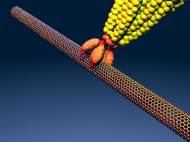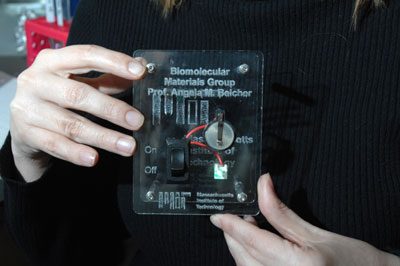Bacteriophage which produce nanoscale electronics
 For the first time, MIT researchers have shown they can genetically engineer viruses to build both the positively and negatively charged ends of a lithium-ion battery. Angela Belcher, the MIT materials scientist who led the research team said “The new virus-produced batteries have the same energy capacity and power performance as state-of-the-art rechargeable batteries being considered to power plug-in hybrid cars, and they could also be used to power a range of personal electronic devices”. The viruses are a common bacteriophage, which infect bacteria but are harmless to humans.
For the first time, MIT researchers have shown they can genetically engineer viruses to build both the positively and negatively charged ends of a lithium-ion battery. Angela Belcher, the MIT materials scientist who led the research team said “The new virus-produced batteries have the same energy capacity and power performance as state-of-the-art rechargeable batteries being considered to power plug-in hybrid cars, and they could also be used to power a range of personal electronic devices”. The viruses are a common bacteriophage, which infect bacteria but are harmless to humans.
The new batteries could be manufactured with a cheap and environmentally friendly process: The synthesis takes place at and below room temperature and requires no harmful organic solvents, and the materials that go into the battery are non-toxic. Unlike traditional lithium-ion battery where lithium ions flow between a negatively charged anode (usually graphite) and the positively charged cathode (usually cobalt oxide or lithium iron phosphate) the viruses build an anode by coating themselves with cobalt oxide and gold and self-assembling to form a nanowire.
“In the latest work, the team focused on building a highly powerful cathode to pair up with the anode”, said Belcher, the Germeshausen Professor of Materials Science and Engineering and Biological Engineering. “Cathodes are more difficult to build than anodes because they must be highly conducting to be a fast electrode, however, most candidate materials for cathodes are highly insulating (non-conductive).”
To achieve that, the researchers, including MIT Professor Gerbrand Ceder of materials science and Associate Professor Michael Strano of chemical engineering, genetically engineered viruses that first coat themselves with iron phosphate, then grab hold of carbon nanotubes to create a network of highly conductive material.
Each iron phosphate nanowire can be electrically “wired” to conducting carbon nanotube networks because the viruses recognize and bind specifically to certain materials (carbon nanotubes in this case). Electrons can travel along the carbon nanotube networks, percolating throughout the electrodes to the iron phosphate and transferring energy in a very short time.
The team found that incorporating carbon nanotubes increases the cathode’s conductivity without adding too much weight to the battery. In lab tests, batteries with the new cathode material could be charged and discharged at least 100 times without losing any capacitance. That is fewer charge cycles than currently available lithium-ion batteries, but the researchers expect them to be able to go much longer.
The prototype is packaged as a typical coin cell battery, but the technology allows for the assembly of very lightweight, flexible and conformable batteries that can take the shape of their container.
“Now that the researchers have demonstrated they can wire virus batteries at the nanoscale, they intend to pursue even better batteries using materials with higher voltage and capacitance, such as manganese phosphate and nickel phosphate”, said Belcher, “Once that next generation is ready, the technology could go into commercial production.”
This entirely new approach to nano-production does appear greener, and though there is some genetic engineering involved it doesn’t raise too much disagreement with the project development.










I’m just waiting for green activists and celebrities which will defend the bacteriophage rights. Nice idea, hope it will be developed in the right direction and for the right reasons.